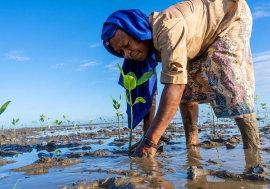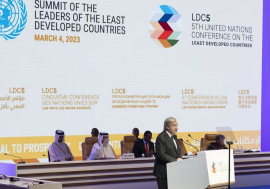Poverty is worsening in African LDCs
Poverty is worsening in African LDCs
Compared with least developed countries in other parts of the world, poverty in African LDCs is rising markedly, says the UN Conference on Trade and Development (UNCTAD). According to the agency, the proportion of people in 29 African LDCs living below $2 per day increased from 82 per cent in the late 1960s to 87.5 per cent in the late 1990s. For those in extreme poverty -- under $1 per day -- the increase was from 55.8 per cent to 64.9 per cent, reports UNCTAD's Least Developed Countries 2002, released in June. The number of Africans living in extreme poverty in these countries rose dramatically from 89.6 million to 233.5 million over the same period.
The UN has classified 49 countries around the world as LDCs, based on their low GDP per capita, weak human resource base and low level of economic diversification. Of that number, 33 are in sub-Saharan Africa, with most of the rest in Asia and the Pacific.
The UNCTAD report uses a new way to measure poverty. Rather than calculating the proportion of poor people on the basis of only household survey data, as the World Bank and other agencies have done, UNCTAD also uses estimates based on national accounts. This, the report argues, is more accurate in especially poor countries, since household surveys have often underrepresented the poorest sectors of the population, and thereby have led to underestimates of overall poverty levels, both in the past and more recently.
Not only is poverty in African LDCs widening, the study notes, it is also deepening. Among Africans living on less than $1 a day, average daily consumption declined from $0.66 in 1975-79 to $0.59 in 1995-99. In contrast, the average daily consumption of the extremely poor in five Asian LDCs rose from $0.84 to $0.90. The proportion of poor people in Asian LDCs also has declined steadily (see graph).
Commodity dependence
The weak economic performance and increasing poverty in African LDCs, argues UNCTAD, are closely linked to their economies' high dependence on exports of raw materials. Most African LDCs depend on a small number of low value-added commodities such as minerals or agricultural products. This makes them highly vulnerable to fluctuations in the international market, especially with the erosion of primary commodity prices in recent years.
Between 1997 and 2001, copper prices fell by 27 per cent, cotton prices by 39 per cent and coffee prices by 66 per cent, striking a hard blow at the poorly diversified economies of the African LDCs. Only the oil-producing LDCs enjoyed better prospects (Angola, Equatorial Guinea and Sudan). Although oil prices have generally remained low, there has not been a return to the especially low levels of 1997-99, and thus oil has helped to underpin economic growth in these countries.
Successful countries, the report points out, are distinguished by the development of highly productive commodity sectors and growing market shares. Even the poor Asian LDCs are less dependent on primary commodity exports than their counterparts in Africa.
Commodity dependency hinders economic growth and worsens poverty in LDCs, the report stresses. These countries are connected to the global economy in a complex web of dependent trade and financial ties with the developed countries. Globalization, argues the report, tightens rather than loosens an "international poverty trap."
How is the trap created? Narrow, static, low-value commodity dependence causes slow export growth. That leads to unsustainable external debt, and even greater reliance on aid. Consequently, state capacities weaken, contributing to political instability and conflict. This worsens poverty, weakens corporate capacities and scares off investors, leaving the country even more reliant on commodity exports.
In an effort to lessen such dependence, a number of LDCs have turned to tourism as a main source of foreign exchange earnings. The report points out that for many LDCs, however, the desired benefits of a thriving tourism industry are undermined by financial "leakage." This occurs through the repatriation of profits to the investor's country of origin, remittances sent abroad by foreign workers, and the import of goods and services necessary for the industry. Without strong links with the local population, tourism typically contributes little to poverty reduction.
Adverse effects of trade liberalization
The report urges LDCs to consider more restrictive international trade policies, rather than the kind of sweeping trade liberalization advocated by the International Monetary Fund (IMF) and donors. Studies have shown that so far trade liberalization has not been closely associated with poverty reduction. In fact, based on an IMF index of trade restrictiveness, UNCTAD estimates that poverty is increasing in those developing economies that have the most open trade regimes. The report acknowledges, however, that there is no evidence that there would be a decrease in poverty in the absence of trade liberalization, making it hard to draw firm conclusions.
Nevertheless, the evidence that trade liberalization has had negative consequences is strong. The Senegalese tomato industry is a telling example. In 1990-91, production of tomato concentrate in Senegal was 73,000 tonnes. Over the past seven years, total production has fallen to less than 20,000. One key reason, reports UNCTAD, was trade liberalization, as tomato imports -- mainly from subsidized exporters in the European Union -- flooded the Senegalese market.






















